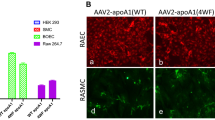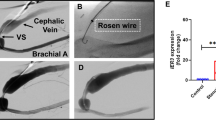Abstract
The present study investigated a novel approach for gene therapy of heart valve disease and vascular disorders. We formulated and characterized implantable polyurethane films that could also function as gene delivery systems through the surface attachment of replication defective adenoviruses using an anti-adenovirus antibody tethering mechanism. Our hypothesis was that we could achieve site-specific gene delivery to cells interacting with these polyurethane implants, and thereby demonstrate the potential for intravascular devices that could also function as gene delivery platforms for therapeutic vectors. Previous research by our group has demonstrated that polyurethane elastomers can be derivatized post-polymerization through a series of chemical reactions activating the hard segment amide groups with alkyl bromine residues, which can enable a wide variety of subsequent chemical modifications. Furthermore, prior research by our group investigating gene delivery intravascular stents has shown that collagen-coated balloon expandable stents can be configured with anti-adenovirus antibodies via thiol-based chemistry, and can then tether adenoviral vectors at doses that lead to high levels of localized arterial neointima expression, but with virtually no distal spread of vector. Thus, we sought to create two-device configurations for our investigations building on this previous research. (1) Polyurethane films coated with Type I collagen were thiol activated to permit covalent attachment of anti-adenovirus antibodies to enable gene delivery via vector tethering. (2) We also formulated polyurethane films with direct covalent attachment of anti-adenovirus antibodies to polyurethane hard segments derivatized with alkyl–thiol groups, thereby also enabling tethering of replication-defective adenoviruses. Both formulations demonstrated highly localized and efficient transduction in cell culture studies with rat arterial smooth muscle cells. In vivo experiments with collagen-coated polyurethane films investigated an abdominal aorta implant model in pigs using a button configuration that simulated the blood contacting environment of a vascular graft. One week explants of the collagen-coated polyurethane films demonstrated 14.3±2.5% of neointimal cells on the surface of the implant transduced with green fluorescent protein – adenovirus (AdGFP) vector loadings of 1 × 108 PFU. PCR studies demonstrated no detectable vector DNA in blood or distal organs. Similarly, polyurethane films with direct attachment of antivector antibodies to the surface were used in sheep pulmonary valve leaflet replacement studies, simulating the blood contacting environment of a prosthetic heart valve cusp. Polyurethane films with antibody tethered AdGFP vector (108 PFU) demonstrated 25.1±5.7% of attached cells transduced in these 1 week studies, with no detectable vector DNA in blood or distal organs. In vivo GFP expression was confirmed with immunohistochemistry. It is concluded that site-specific intravascular delivery of adenoviral vectors for gene therapy can be achieved with polyurethane implants utilizing the antivector antibody tethering mechanism.
This is a preview of subscription content, access via your institution
Access options
Subscribe to this journal
Receive 12 print issues and online access
$259.00 per year
only $21.58 per issue
Buy this article
- Purchase on Springer Link
- Instant access to full article PDF
Prices may be subject to local taxes which are calculated during checkout






Similar content being viewed by others
References
Grossman PM et al. Incomplete retention after direct myocardial injection. Cath Cardiol Int 2002; 55: 392–397.
Sinnaeve P, Varenne O, Collen D, Janssens S . Gene therapy in the cardiovascular system: an update. Cardiol Res 1999; 44: 498–506.
Feldman LJ, Tahlil O, Steg PG . Adenovirus-mediated arterial gene therapy for restenosis: problems, perspectives. Semin Int Cardiol 1996; 1: 203–208.
Klugherz BD et al. Gene delivery from a DNA controlled-release stent in porcine coronary arteries. Nat Biotechnol 2000; 18: 1181–1184.
Klugherz BD et al. Gene delivery to pig coronary arteries from stents carrying antibody-tethered adenovirus. Hum Gene Ther 2002; 13: 443–454.
Abrahams JM et al. Endovascular microcoil gene delivery using immobilized anti-adenovirus antibody for vector tethering. Stroke 2002; 33: 1376–1382.
Levy RJ et al. Localized adenovirus gene delivery using antiviral IgG complexation. Gene Therapy 2001; 8: 659–667.
Alferiev I, Vyavahare N, Song C, Levy R . Elastomeric polyurethanes modified with geminal bisphosphonate groups. J Polym Sci 2001; 39: 105–116.
Alferiev I et al. Bisphosphonate derivatized polyurethanes resist calcification. Biomaterials 2001; 22: 2683–2693.
Alferiev I et al. Prevention of polyurethane valve cusp calcification with covalently attached bisphosphonate diethylamino moieties. J Biomed Mater Res 2003; 66: 385–395.
Bernacca GM . Polyurethane heart valve durability: effects of leaflet thickness and material. J Heart Lung Transpl 1997; 16: 596–599.
Bernacca GM . Calcification and stress distribution in bovine pericardial heart valves. Int J Art Org 1992; 15: 284–288.
Bernacca GM . In vitro function and durability of a polyurethane heart valve: material considerations. Biomaterials 1996; 17: 1857–1863.
Bernacca GM . In vitro blood compatibility of surface-modified polyurethanes. Int J Cardiol 1998; 64: 221–223.
Bernacca GM . Surface modification of polyurethane heart valves: effects on fatigue life and calcification. Biomaterials 1998; 19: 1151–1165.
Joshi RR, Frautschi JR, Phillips RE, Levy RJ . Phosphonated polyurethanes that resist calcification. J Appl Biomater (New York). 1994; 5: 65–77.
Schilling JA . Wound healing. Phys Rev 1968; 48: 374–423.
Viljanto J, Rajamaki A . Cellular patterns in the early phase of healing wounds in children. Scand J Plast Reconstr Surg 1976; 10: 83–89.
Wheatley DJ . Polyurethane: material for the next generation of heart valve prostheses? Eur J Cardio-Thorac Surg 2000; 17: 355–361.
Maillard L, Walsh K . Growth-arrest homeobox gene Gax: a molecular strategy to prevent arterial restenosis. Schweiz Med Wochen J Suisse Med 1996; 126: 1721–1726.
Chang MW, Leiden JM . Gene therapy for vascular proliferative disorders. Semin Int Cardiol 1996; 1: 185–193.
Morishige K et al. In vivo gene transfer of dominant-negative rho-kinase induces regression of coronary arteriosclerosis in pigs. Ann N Y Acad Sci 2001; 947: 407–411.
Kanerva A et al. Targeting adenovirus to the serotype 3 receptor increases gene transfer efficiency to ovarian cancer cells. Clin Cancer Res 2002; 8: 275–280.
Krasnykh V et al. Genetic targeting of an adenovirus vector via replacement of the fiber protein with the phage T4 fibritin. J Virol 2001; 75: 4176–4183.
Ebbinghaus C et al. Functional and selective targeting of adenovirus to high-affinity Fcgamma receptor I-positive cells by using a bispecific hybrid adapter. J Virol 2001; 75: 480–489.
Barnett BG, Crews CJ, Douglas JT . Targeted adenoviral vectors. Biochim Biophys Acta 2002; 1575: 1–14.
Wisman CB et al. A polyurethane trileaflet cardiac valve prosthesis: in vitro and in vivo studies. Trans Am Soc Art Int Org 1982; 28: 164–168.
Acknowledgements
The authors thank Ms Jennifer LeBold for the manuscript preparation. Research support was provided in part by NHLBI Grants R01- HL59730 (Drs Levy and Alferiev) and T32 HL07915 (Dr Stachelek), an American Heart Association Grant-in-Aid (Dr Alferiev), and by a grant from the Nanotechnology Institute (Dr Levy). Dr Levy's efforts were also supported by the William J Rashkind Endowment of the Children's Hospital of Philadelphia.
Author information
Authors and Affiliations
Rights and permissions
About this article
Cite this article
Stachelek, S., Song, C., Alferiev, I. et al. Localized gene delivery using antibody tethered adenovirus from polyurethane heart valve cusps and intra-aortic implants. Gene Ther 11, 15–24 (2004). https://doi.org/10.1038/sj.gt.3302129
Received:
Accepted:
Published:
Issue Date:
DOI: https://doi.org/10.1038/sj.gt.3302129
Keywords
This article is cited by
-
Engineering Biomaterial Systems to Enhance Viral Vector Gene Delivery
Molecular Therapy (2011)
-
Hydrogels to modulate lentivirus delivery in vivo from microporous tissue engineering scaffolds
Drug Delivery and Translational Research (2011)
-
Surface immobilization of hexa-histidine-tagged adeno-associated viral vectors for localized gene delivery
Gene Therapy (2010)
-
Spatially Patterned Gene Delivery for Localized Neuron Survival and Neurite Extension
Molecular Therapy (2007)



